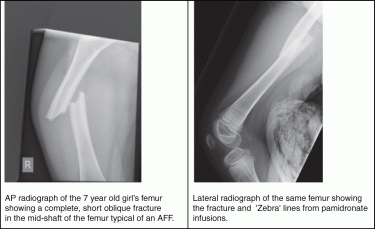ICCBH2017 Poster Presentations (1) (209 abstracts)
Atypical femoral fractures in 2 children treated with bisphosphonates
Benjamin Jacobs 1 , Caroline Brain 2 , Catherine DeVile 2 , Jeremy Allgrove 2 , Daniela Peeva 1 , Aresh Hashemi-Nejad 1 & M Zulf Mughal 3
1Royal National Orthopaedic Hospital, Stanmore, UK; 2Great Ormond Street Hospital, London, UK; 3Royal Manchester Childrens Hospital, Manchester, UK.
Background: Atypical Femur Fracture (AFF) has become widely reported as a complication of bisphosphonate therapy in adults since the first case report in 2005. A trend towards a similar pattern of fractures has been reported in children in Sheffield in 2012. A 13 year old boy was reported in 2014 with an ‘AFF’ of the tibia but that fracture did not meet the standard diagnostic criteria of AFF. Last year a 16-year-old girl treated with pamidronate for idiopathic juvenile osteoporosis was reported with an AFF and multiple AFF’s were reported in a teenage girl with OI type IV.
Presenting problem: A 13 year old girl started bisphosphonate treatment in 2009. The indication for treatment was unusual (heterozygous LRP5 mutation). She developed a classic AFF at 18 years of age. She had features recognised as AFF risk factors in adults: Asian origin, vitamin D deficiency and long term bisphosphonate treatment (6 years). A 10 month old baby girl presented with a fractured femur. She, and her older brother, were diagnosed with Osteogenesis Imperfecta (OI) Type I and found to have a COL1A1 c697-1 C>G mutation. She started intravenous pamidronate treatment at 5 years of age, and presented at 7 years of age with an AFF.
Clinical management: Both girls had surgery to fix their AFF. The patient with heterozygous LRP5 mutation stopped bisphosphonate treatment as she is now an adult, but we plan to continue a lower dose treatment for the younger patient with OI.
Discussion: AFF must now be considered as a complication of bisphosphonate therapy in childhood. The risk of AFF should be considered when weighing up the clear benefits of this therapy in severe cases of OI and other more rare disorders. However it may be safer to withhold, or limit, bisphosphonate treatment in children with milder bone disease.

Disclosure: The authors declared no competing interests.
 }
}



